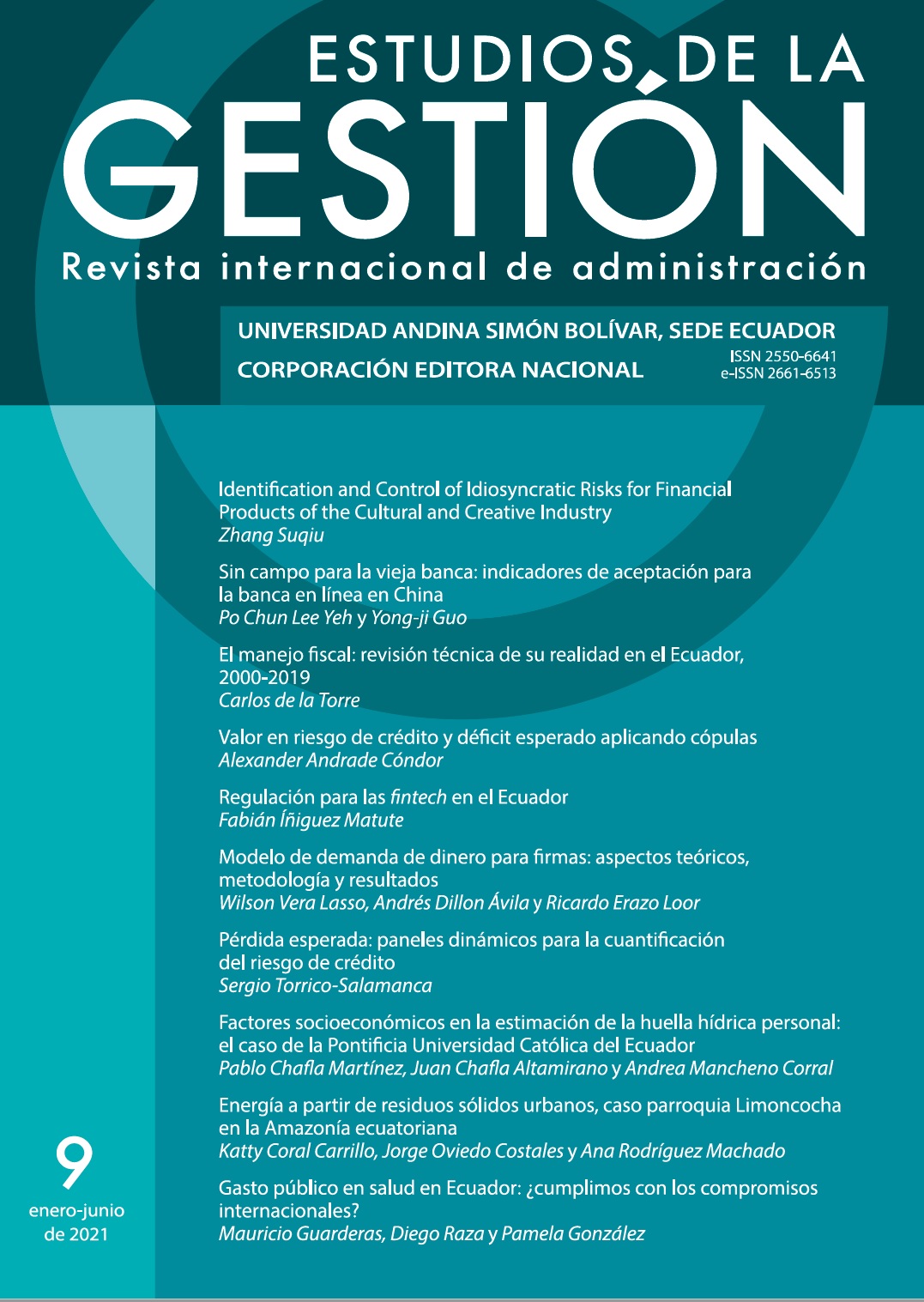Sem espaço para bancos velhos: indicadores de aceitação para o internet banking da China
DOI:
https://doi.org/10.32719/25506641.2021.9.2Palavras-chave:
Internet banking, rede neuronal artificial, China, preferência clientes, inovação tecnológicaResumo
A inovação tecnológica e as mudanças nos estilos de vida (particularmente devido à pandemia do COVID-19) fizeram com que as interações entre consumidores e bancos mudassem subitamente. Este documento estuda múltiplos indicadores que afetam a aceitação do internet banking na China, incluindo preferência do cliente, fatores referentes ao internet banking, fatores sociais e outros. Realizaram-se questionários dirigidos a pequenos e microempresários, executivos de bancos comerciais e clientes bancários. Elaborou-se também um modelo de rede neuronal artificial com dados que compreendem mais de mil grupos. Os resultados demonstram que a atitude em relação à segurança da conta, à compreensão das vantagens do internet banking e à avaliação do risco do prestatário, além da atitude do cliente com respeito ao sistema de informação creditícia, são fatores relativamente importantes e que afetam a aceitação do internet banking. A direção de impacto de cada indicador mostra que é mais provável que os clientes aceitem o internet banking caso haja maior segurança, mais conveniência, menor risco para os clientes e um sistema de informação e vigilância de crédito mais desenvolvido. Em contrapartida, os indicadores para aplicativos de telefonia móvel, funções auxiliares, regulamentações e operações do internet banking são relativamente menos importantes.
Downloads
Referências
Aboobucker, Ilmudeen, y Yukun Bao. 2018. “What Obstruct Customer Acceptance of Internet Banking? Security and Privacy, Risk, Trust and Website Usability and The Role of Moderators”. The Journal of High Technology Management Research 29 (1): 109-123. 10.1016/j.hitech.2018.04.010.
Alalwan, Alí Alalwan, Dwivedi Yogesh Kumar, Rana Nripendra, Banita Lal y Michael Williams. 2015. “Consumer Adoption of Internet Banking in Jordan: Examining the Role of Hedonic Motivation, Habit, Self-efficacy and Trust”. Journal of Financial Services Marketing 20 (2): 145-157. 10.1057/fsm.2015.5.
Al-Jabri, Ibrahim, y Sohail Sadiq. 2012. “Mobile Banking Adoption: Application of Diffusion of Innovation Theory”. Journal of Electronic Commerce Research 13 (4): 379-391.
Al-Smadi, Mohammad. 2012. “Factors Affecting Adoption of Electronic Banking: An Analysis of the Perspectives of Banks’ Customers”. International Journal of Business and Social Science 3 (17): 294-300. https://bit.ly/3bW93g9.
Boateng, Henry, Adam Diyawu, Abednego Okoe y Thomas Anning-Dorson. 2016. “Assessing the Determinants of Internet Banking Adoption Intentions: A Social Cognitive Theory Perspective”. Computers in Human Behavior 65: 468-478. 10.1016/j.chb.2016.09.017.
Bojan, Daniela, Simona Mutu y Dragos Păun. 2010. “Electronic Banking-Advantages for Financial Services Delivery”. Annals of Faculty of Economics 1 (2): 672-677.
Chan, Siu Cheng. 2004. “Understanding Internet Banking Adoption and Use Behavior: A Hong Kong Perspective”. Journal of Global Information Management (JGIM) 12 (3): 21-43. 10.4018/jgim.2004070102.
Chauhan, Vikas, Rambalak Yadav y Vipin Choudhary. 2019. “Analyzing the Impact of Consumer Innovativeness and Perceived Risk in Internet Banking Adoption”. International Journal of Bank Marketing 37 (1) 323-339. 10.1108/IJBM-02-2018-0028.
Diniz, Eduardo, Roseli Morena Porto y Tomi Adachi. 2005. “Internet Banking in Brazil: Evaluation of Functionality, Reliability and Usability”. The Electronic Journal of Information Systems Evaluation 8 (1): 41-50.
Garson, David. 1991. “A Comparison of Neural Network and Expert Systems Algorithms with Common Multivariate Procedures for Analysis of Social Science Data”. Social Science Computer Review 9 (3): 399-434. 10.1177/089443939100900304.
Gerrard, Philip, Barton Cunningham y James Devlin. 2006. “Why Consumers Are Not Using Internet Banking: A Qualitative Study”. Journal of Services Marketing 20 (3): 160-168. 10.1108/08876040610665616.
Hanafizadeh, Payam, Byron Keating y Hamid Khedmatgozar. 2014. “A Systematic Review of Internet Banking Adoption”. Telematics and Informatics 31 (3): 492-510. 10.1016/j.tele.2013.04.003.
Heidenreich, Sven, y Patrick Spieth. 2013. “Why Innovations Fail-The Case Of Passive and Active Innovation Resistance”. International Journal of Innovation Management 17 (05): 135-145. 10.1142/S1363919613500217.
Hoehle, Hartmut, Eusebio Scornavacca y Sid Huff. 2012. “Three Decades of Research on Consumer Adoption and Utilization of Electronic Banking Channels: A Literature Analysis”. Decision Support Systems 54 (1): 122-132. 10.1016/j.dss.2012.04.010.
Hornik, Kurt. 1993. “Some New Results on Neural Network Approximation”. Neural Networks 6 (8): 1069-1072. 10.1016/S0893-6080(09)80018-X.
Joseph, Mathew, Cindy McClure y Beatriz Joseph. 1999. “Service Quality in the Banking Sector: The Impact of Technology on Service Delivery”. International Journal of Bank Marketing 17 (4): 182-191. https://bit.ly/2FkSm28.
King, Brett. 2012. Bank 3.0: Why Banking is no Longer Somewhere you go but Something you Do. Nueva Jersey: John Wiley & Sons.
Kleijnen, Mirella, Nick Lee y Martin Wetzels. 2009. “An Exploration of Consumer Resistance to Innovation and its Antecedents”. Journal of Economic Psychology 30 (3): 344-357.
1016/j.joep.2009.02.004.
Laukkanen, Tommi. 2016. “Consumer Adoption vs Rejection Decisions in Seemingly Similar Service Innovations: The Case of the Internet and Mobile Banking”. Journal of Business
Research 69 (7): 2432-2439. 10.1016/j.jbusres.2016.01.013.
Lee, Ming Chi. 2009. “Factors Influencing the Adoption of Internet Banking: An Integration of TAM and TPB with Perceived Risk and Perceived Benefit”. Electronic Commerce Research
and Applications 8 (3): 130-141. 10.1016/j.elerap.2008.11.006.
Martins, Carolina, Tiago Oliveira y Ales Popovič. 2014. “Understanding the Internet Banking Adoption: A Unified Theory of Acceptance and Use of Technology and Perceived Risk Application”. International Journal of Information Management 34 (1): 1-13. 10.1016/j.ijinfomgt.2013.06.002.
Nami, Mohammad Reza. 2009. “E-banking: Issues and Challenges”. En 10th ACIS International Conference on Software Engineering, Artificial Intelligences, Networking and Parallel/
Distributed Computing, 263-266. Institute of Electrical and Electronics Engineers, Daegu. 10.1109/SNPD.2009.60.
Pikkarainen, Tero, Kari Pikkarainen, Heikki Karjaluoto y Seppo Pahnila. 2004. “Consumer Acceptance of Online Banking: An Extension of the Technology Acceptance Model”. Internet
Research 4 (3): 224-235. 10.1108/10662240410542652.
Rotchanakitumnuai, Siriluck, y Mark Speece. 2003. “Barriers to Internet Banking Adoption: A Qualitative Study among Corporate Customers in Thailand”. International Journal of Bank Marketing 21 (6/7): 312-323. 10.1108/02652320310498465.
Shaikh, Aijaz, y Heikki Karjaluoto. 2015. “Mobile Banking Adoption: A Literature Review”. Telematics and Informatics 32 (1): 129-142. 10.1016/j.tele.2014.05.003.
Sharma, Sonia. 2016. “A Detail Comparative Study on E-Banking vs Traditional Banking”. International Journal of Advanced Research 2 (7): 302-307. https://bit.ly/2Fn4SOC.
Tan, Margaret, y Teo Thompson. 2000. “Factors Influencing the Adoption of Internet Banking”. Journal of the Association for information Systems 1 (1): 5. 10.17705/1jais.00005.
Vives, Xavier. 2019. “Digital Disruption in Banking”. Annual Review of Financial Economics 11: 243-272. https://doi.org/10.1146/annurev-financial-100719-120854.
Welsch, Heinz, y Susana Ferreira. 2014. “Environment, Well-Being, and Experienced Preference”. Working Paper 367 (14). Universitat Oldenburg, Oldenburg.
http://hdl.handle.net/10419/105055.
Wu, Jen-Her, Tzyh-Li Hsia y Michael Heng. 2006. “Core Capabilities for Exploiting Electronic Banking”. Journal of Electronic Commerce Research 7 (2): 111-119. https://bit.ly/33qPQ25.
Yu, Chian-son. 2012. “Factors Affecting Individuals to Adopt Mobile Banking: Empirical Evidence from the UTAUT Model”. Journal of Electronic Commerce Research 13 (2): 104-121. https://bit.ly/3mfhgR8.
Zhao, Ding, Ruolei Gu, Ping Tang, Qiwei Yang y Yue-Jia Luo. 2016. “Incidental Emotions Influence Risk Preference and Outcome Evaluation”. Psychophysiology 53 (10): 1542- 1551. 10.1111/psyp.12694.
Zhang, Yun, Qingxiong Weng y Nan Zhu. 2018. “The Relationships Between Electronic Banking Adoption And its Antecedents: A Meta-Analytic Study of the Role of National Culture”. International Journal of Information Management 40: 76-87. 10.1016/j.ijinfomgt.2018.01.015.
Zolait, Ali Hussein, y Ainin Sulaiman. 2017. “The Influence of Communication Channels on Internet Banking Adoption”. Asian Journal of Business Accounting. Hong Kong (1&2): 115-134. https://bit.ly/2Rtb0ae.













